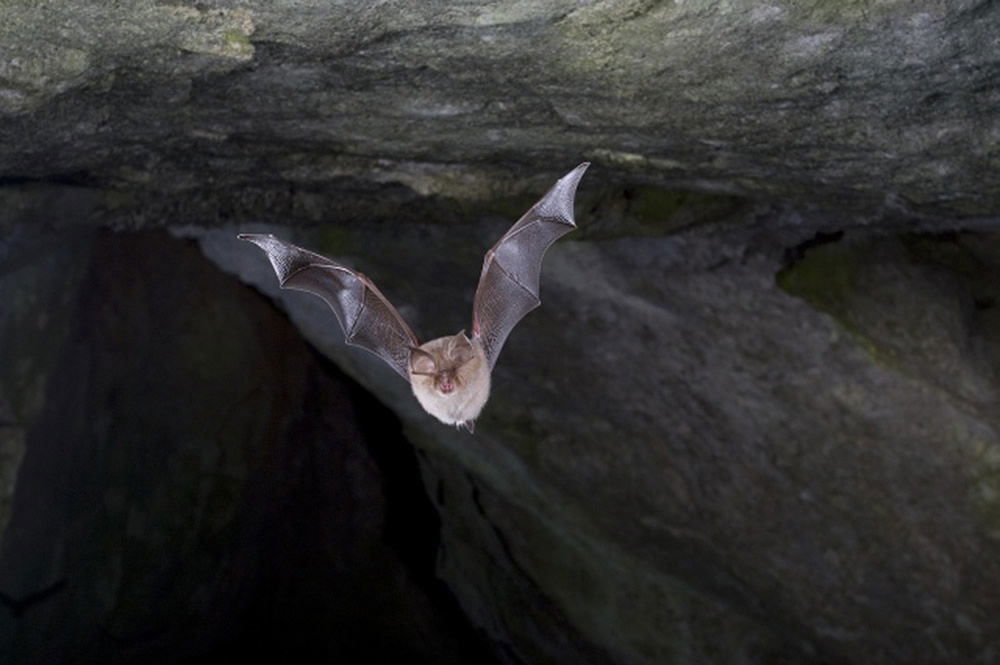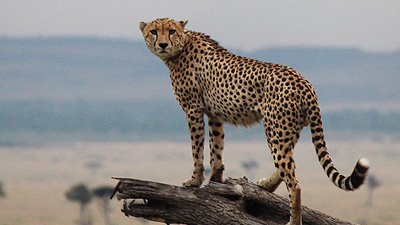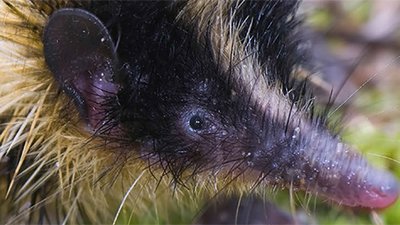
Bats: Equipped for the Hunt
Life as a Bat
Dusk falls on the farm, and most of the animals are settling down for the night in the old red barn. For some uninvited tenants, however, the day has just begun. Roosting upside down on the barn rafters, their chirping fills the hayloft as they prepare for departure. Through the open hay mow door, they fly out by the hundreds. At this opportunistic moment, a waiting owl swoops down and snags one of them. But once these agile creatures are out hunting on their own, they are hard to catch.
In the air, the big brown bats dart one way and then the other, chasing flittering insects. As the only true flying mammals, bats are well equipped for the hunt. Their wings can maneuver nimbly to abruptly change directions and carry them swiftly up to 40 miles per hour.1 Big brown bats also use their one-foot wingspan like a net to catch insects.2 The prey of bats includes pesky mosquitoes and agricultural pests like cucumber beetles.3 But how can they see the tiny insects in the dark?
Like most bats, big brown bats use echolocation to sense their surroundings and target their prey. They send out ultrasonic signals that bounce off surrounding objects and echo back to be interpreted as a sort of sound map. These high-pitched sounds are usually undetectable by the human ear, but bat calls can reach intensities of up to 137 decibels, which tops the booming of a rock concert.4 Many bats protect their ears by contracting their ear muscles each time they emit a call.5
Back in the barn, the bats’ young are waiting hungrily. The mother bats of the maternity colony must eat about as much as their body weight6 or more in order to nurse the blind and flightless pups7 that depend on them. After gorging themselves, they return to the barn. Chirps and squeaks fill the hayloft as the mothers search for their pups among the hundreds of bats. Amazingly, they’re able to find their own by call and odor.8 One pup has fallen from its roost and squeaks for help. Before the farm cat finds it, the mother bat picks it up and carries it back to the safety of the roost.
Like other mammals, the bats nurse their young and have hair, which they fastidiously groom. Besides their brown fur, big brown bats have black wings, dog-like snouts with sharp teeth, and perky ears like a Chihuahua. As the sun rises over the rows of corn, the nocturnal bats settle in to sleep and wait for the next hunt.

Image by Hyla meridionalis, via Wikimedia Commons.
Snapshot
- Bats belong to the order Chiroptera, which comes from Greek words meaning “hand wing.” The bat’s wing structure is similar to the structure of the human arm and hand.
- The different bat species number more than 1,000, composing around 20 percent of mammal species. Of these bat species, almost three quarters feed on insects. Most of the remainder feed on fruit. In fact, some tropical plants continue to exist because bats distribute their seeds. Some bats feed on the nectar of flowers with their long tongues and contribute to pollination. A small number of species feed on vertebrates like frogs. Only three species feed on blood. Two of those species feed on the blood of birds, and the other feeds on the blood of mammals like cows and, rarely, humans. The amount of blood these vampire bats take each night is so small—about one tablespoon9—that their bite is not life threatening for humans, except if they carry rabies. The three species of vampire bats live in Central and South America. Scientists are studying the anticoagulant in the vampire bat’s saliva to help them design a substance that may dissolve clots in stroke victims.
- The smallest bat (as well as the smallest mammal) is the Kitti’s hog-nosed bat or bumblebee bat, which is only about one and a quarter inches long. The largest bat is the giant golden-crowned flying fox of the Philippines, which weighs about three pounds and has a wingspan of about five feet.
- The world’s largest bat colony consists of more than 20 million bats at Bracken Cave in Texas. This colony may eat 250 tons of insects in one night. This massive quantity is not surprising considering one small brown bat can capture more than 600 mosquitoes in one hour. (See “Bats: Sophistication in Miniature.”)
- Farmers use nutrient-rich bat dung, called guano, to fertilize their fields.
- To survive the winter months, many bats either migrate south or hibernate. Bats have an incredible ability to navigate, with gray bats traveling up to a few hundred miles to reach a specific hibernation cave.10 Studies show that bats may sense the earth’s magnetic field to help them navigate.11
- Threats to bats include diseases like white nose syndrome, predators like hawks and snakes, and even structures like wind turbines. Many young bats do not survive their first hibernation because they did not store enough fat. But bats can live more than 20 years.
Divine Design
Your evolutionist friend has been taught that bats evolved millions of years ago from a small, nonflying mammal like a shrew or gliding squirrel. Somehow, random mutation and natural selection got it right over time as skin stretched out to form wings with the precise bone, muscle, and nerve structure for the unique flying mechanism of the bat. Such a complex change by mindless processes is not as simple as evolutionists would imagine, as Dr. Randy Guliuzza explains:
Bat wings integrate unique properties in regard to composition, shape, and movement. In flight, tremendously elastic wing skin is cyclically folded close to the body, then rapidly extended in precisely coordinated motions. Extremely synchronized rapid twitch muscles deftly modulate bone interactions at dozens of joints, allowing subtle alterations of wing shape. Thus, at slow speeds, bats generate more lift and greater maneuverability than many birds.12
If bats evolved as the only flying mammal, evidence of transitional creatures should be found in the fossil record. However, the earliest bats in the fossil record have fully developed wings and other characteristic bat features. For example, Palaeochiropteryx tupaiodon was an early bat that had the inner ear structure of today’s bats, enabling echolocation. Discoveries of fossil bats that perhaps didn’t possess echolocation abilities is not a clincher for evolution because a whole sub-order of bats today—the megabats—do not echolocate (with one genus as the exception).
The megabat and microbat distinction is a mystery for evolutionists. Although the two sub-orders share many features, the differences defy evolution from a common ancestor. Some evolutionists now believe the two suborders evolved independently. Some think the megabats may have a common ancestor with the primates because both have brains with intricate visual pathways.
From a creationist perspective, the similarities between megabat and primate brains or microbat and dolphin echolocation are easy to explain. Such similarities show neither parallel (convergent) evolution nor a common ancestor but rather show common design. God created the animals with similar designs yet unique characteristics to fulfill his purpose for them in filling the earth (Genesis 1:22).
Bats have certainly filled the earth, fulfilling crucial roles in seed distribution, pollination, and insect control. Many people, however, fear bats as rabies carriers and “blood suckers.” The predation of animals is a result of the Fall. Sinful man is to blame for the entry of sin and death into the world (Romans 5:12). Yet God sent his Son to live a perfect life, die to take the punishment for sin, and rise from the dead in victory for those who turn to him in repentance and faith. “For the wages of sin is death, but the free gift of God is eternal life in Jesus Christ our Lord” (Romans 6:23).
Creation Corner
Remember that everything was cursed because of man's sin (think specifically of the ground and serpent mentioned in Genesis 3). Death then intruded upon God’s perfect creation, so animals, people, and plants have had to fight for survival ever since. Because of the Curse, traits developed that would have been unnecessary before Adam sinned, like venom and stingers for attack and defense. Keep in mind, though, that not all deadly looking features necessarily had to develop! Fruit bats are a great example of how mean-looking teeth can work just as well for ripping apart vegetation, not flesh! For more about how and why deadly structures are now a part of our world, see “How Did Defense/Attack Structures Come About?”
Of course some animals are impressive for their beauty and design, too. Seeing things through the lens of Scripture, we see an all-wise and intelligent God who spoke animals into existence in a perfect world that was soon marred by sin and death. We can praise the Creator for a remnant of that incredible beauty and design still. And God has also thus provided us with examples of his intelligence and provision that we can put to good use in biomimicry. Join us in giving glory to God for his loving care for us and his creation, despite the curse.
– Editor
Footnotes
- “Big Brown Bat: Eptesicus fuscus,” accessed January 10, 2011, http://www.fcps.edu/islandcreekes/ecology/big_brown_bat.htm.
- Ibid.
- “Eptesicus fuscus,” Bat Conservation International, accessed January 10, 2011, http://www.batcon.org/index.php/all-about-bats/species-profiles.html?task=detail&species=1890&country=43&state=all&family=all&limitstart=0.
- Colin Barras, “Bat Squeaks Louder than a Rock Concert,” NewScientist.com, April 30, 2008, http://www.newscientist.com/article/dn13799-bat-squeaks-louder-than-a-rock-concert.html.
- Ibid.
- “Eptesicus fuscus: Big Brown Bat,” accessed January 10, 2011, http://animaldiversity.ummz.umich.edu/site/accounts/information/Eptesicus_fuscus.html.
- “Animal Fact Sheet: Big Brown Bat,” accessed January 10, 2011, http://www.desertmuseum.org/kids/bats/Big%20Brown%20Bat.php.
- “Order Chiroptera: Bats,” accessed January 10, 2011, http://animaldiversity.ummz.umich.edu/site/accounts/information/Chiroptera.html.
- “Bats of the World,” Bat Conservation Trust, accessed January 10, 2011, http://www.bats.org.uk/pages/bats_of_the_world.html.
- Merlin D. Tuttle, “How North America’s Bats Survive the Winter,” Bat Conservation International, accessed January 10, 2011, https://www.batcon.org/article/how-north-america/.
- “Bats Have Magnetic Super-Sense Too,” NewScientist.com, December 6, 2006, http://www.newscientist.com/article/mg19225815.400.
- Dr. Randy Guliuzza, “Discovering Life’s Complex Patterns of Design,” accessed April 23, 2013, http://www.icr.org/article/discovering-lifes-complex-patterns/.

Answers in Genesis is an apologetics ministry, dedicated to helping Christians defend their faith and proclaim the good news of Jesus Christ.
- Customer Service 800.778.3390
- © 2024 Answers in Genesis



